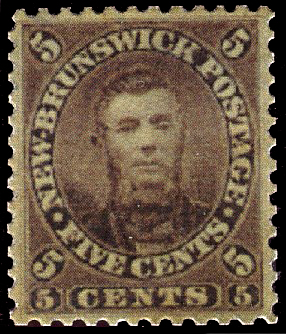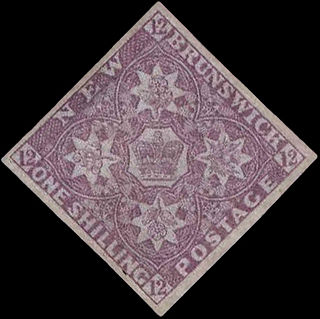Related Research Articles

Philately is the study of postage stamps and postal history. It also refers to the collection and appreciation of stamps and other philatelic products. While closely associated with stamp collecting and the study of postage, it is possible to be a philatelist without owning any stamps. For instance, the stamps being studied may be very rare or reside only in museums.

Charles Connell was a Canadian politician, now remembered mainly for placing his image on a 5-cent postage stamp. Born in Northampton in the then-British colony of New Brunswick to a family of Loyalists who had fled the American Revolution, he entered politics in 1846, serving in the colony's Legislative Assembly and House of Assembly.

The postal and philatelic history of Canada concerns postage of the territories which have formed Canada. Before Canadian confederation, the colonies of British Columbia and Vancouver Island, Prince Edward Island, Nova Scotia, New Brunswick and Newfoundland issued stamps in their own names. The postal history falls into four major periods: French control (1604–1763), British control (1763–1841), colonial government control (1841–1867), and Canada, since 1867.

L.N. and M. Williams were a philatelic writing partnership made up of brothers Leon Norman Williams and Maurice Williams (1905–1976).

John Harry Robson Lowe was an English professional philatelist, stamp dealer and stamp auctioneer.

The Chalon Head is the name of a number of postage stamp series whose illustration was inspired by a portrait of Queen Victoria by Alfred Edward Chalon (1780–1860).
John Alexander Tilleard was a British solicitor and the philatelist who was the first curator of the Royal Philatelic Collection.

Sir Edward Denny Bacon was a British philatelist who helped with the enlargement and mounting of collections possessed by rich collectors of his time and became the curator of the Royal Philatelic Collection between 1913 and 1938.

Sir John Mitchell Harvey Wilson, 2nd Baronet was a British philatelist and Keeper of the Royal Philatelic Collection from 1938 to 1969. He introduced the division of the collection by reign and, after World War II, loans from the collection to international exhibitions.

Charles Nissen was a British philatelist, and stamp dealer who discovered the famous stock exchange forgery and wrote, with Bertram McGowan, the definitive book on the plating of the Penny Black.
Quindalious Greene was a Canadian philatelist, so prominent in the field of Canadian philately that he was often referred to as “Canada's Grand Old Man” by fellow philatelists.
John Easton was a printer and philatelic author who signed the Roll of Distinguished Philatelists in 1960.
Gilbert "Gillie" Harrison was an English philatelist, and rugby union footballer who played in the 1870s and 1880s. He was one of the "Fathers of Philately" entered on the Roll of Distinguished Philatelists in 1921.

The British Library Philatelic Collections is the national philatelic collection of the United Kingdom with over 8 million items from around the world. It was established in 1891 as part of the British Museum Library, later to become the British Library, with the collection of Thomas Tapling. In addition to bequests and continuing donations, the library received consistent deposits by the Crown Agency and has become a primary research collection for British Empire and international history. The collections contain a wide range of artefacts in addition to postage stamps, from newspaper stamps to a press used to print the first British postage stamps.

The Crawford Library is a library of early books about philately formed between 1898 and 1913 by James Lindsay, 26th Earl of Crawford. By the time of his death in 1913, Crawford was thought to have amassed the greatest philatelic library of his time. Today, the library is part of the British Library Philatelic Collections.

This is a survey of the postage stamps and postal history of New Brunswick.

This is a survey of the postage stamps and postal history of Nova Scotia.
Dr. William Robert Denison Wiggins FFARCS MRCS was a British medical practitioner and philatelist who in 1963 was awarded the Crawford Medal by the Royal Philatelic Society London for his work The Postage Stamps of Great Britain Part II.
Philip Thomas Saunders FRPSL was a British banker and philatelist. He started in banking before the First World War but his career was interrupted by service in the Royal Flying Corps during the conflict. Returning to banking after the war, he published a history of Stuckey's Bank in 1928, working for banks that ultimately became today's National Westminster, before retiring in 1959.

Everard Francis Aguilar was a Jamaican horticulturist, stamp dealer, and philatelist.
References
- ↑ Bateman, Robert. Stamp collectors' who's who. London: Stanley Gibbons, 1960, p. 11.
- ↑ Nicholas André (Ambrose) Argenti. www.christopherlong.co.uk 7 February 2012. Retrieved 17 January 2013. Archived here.
- ↑ The Society's medals and honorary fellowship. The Royal Philatelic Society London, 2009, p. 4.
- ↑ "Nova Scotia stamps realize £16,810" in The Times, 9 November 1963, p. 10.